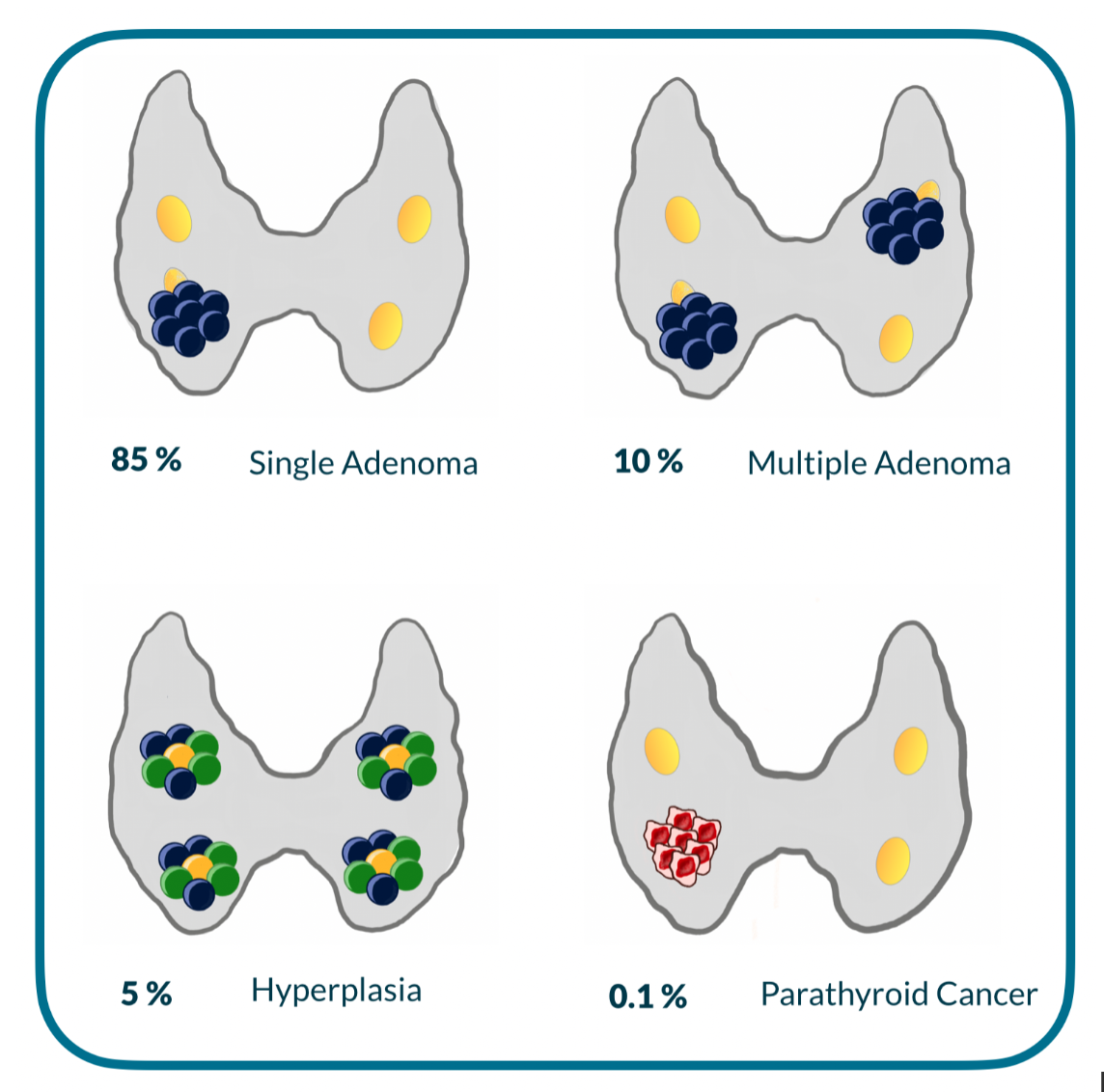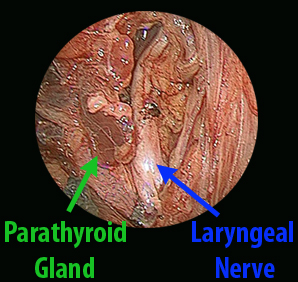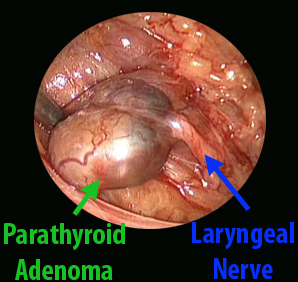Most people know about the butterfly-shaped thyroid gland, which is located in the neck. But there’s another important set of glands next to the thyroid: the parathyroid glands.
Humans have four of these small, rice-sized glands. The parathyroid glands produce parathyroid hormone (PTH), the hormone responsible for controlling the calcium levels in the body.
Just as things can go wrong with the thyroid gland, things can also go wrong with our parathyroid glands. One of the most common parathyroid maladies is hyperparathyroidism caused by a parathyroid adenoma.
The name sounds frightening, but parathyroid adenomas are benign and very treatable, especially if they are caught early. At the CENTER for Advanced Parathyroid Surgery, we deal with hyperparathyroidism & parathyroid adenomas every day. Our board-certified head and neck surgeon, Dr. Babak Larian, cares deeply about each of his patients and provides expert diagnosis and treatment of parathyroid adenomas. Contact our team to learn more about how we can help resolve parathyroid conditions.
What Is Parathyroid Adenoma?
A parathyroid adenoma is a benign tumor growth on one or more parathyroid glands. Adenomas on the parathyroid glands can cause an increase in parathyroid hormone (PTH) production. This leads to a condition known as hyperparathyroidism. HPT, as it’s called, causes increased calcium levels in the blood, or hypercalcemia.
The vast majority (85%) of patients with hyperparathyroidism will have only one parathyroid adenoma. This means that while one gland is enlarged, the other three remain completely normal.
In rarer cases, patients can have a parathyroid adenoma on two, three, or even all four parathyroid glands. Less than 1% of patients will have a cancerous tumor on a parathyroid gland.

What Causes Parathyroid Adenoma?
In most cases, what exactly causes a parathyroid gland to develop a tumor is unknown. Roughly 100,000 new cases of parathyroid disease are diagnosed every year. Hyperparathyroidism caused by a Parathyroid adenoma is most commonly diagnosed among females over the age of 60, but it can happen at any age and any gender.
However, some people are genetically predisposed to develop a parathyroid adenoma. Others may develop a tumor as a result of excessive radiation exposure, or toxin exposure.


Parathyroid Adenoma Symptoms
Hyperparathyroidism is a unique disease in that it affects every patient differently. A parathyroid adenoma can cause a variety of different symptoms. Many of these resemble symptoms of other conditions or medical problems. This can make it challenging to diagnose hyperparathyroidism due to a parathyroid adenoma.
But in general, parathyroid adenoma symptoms can include:
- Bone aches and pains
- Kidney problems
- Abdominal pain
- Depression
- Nausea
- Vomiting
- Fatigue
- Excessive urination
- Muscle weakness
These symptoms can also point to all sorts of other medical conditions, which is why hyperparathyroidism can be difficult for an inexperienced physician to diagnose. That’s why it’s important to find a provider who is specially trained to diagnose and treat parathyroid conditions.
To make things even more complicated, some people with a parathyroid adenoma have no symptoms at all. Learn more about hyperparathyroidism symptoms here.
Diagnosing Parathyroid Adenoma
In many cases, the first sign that something may be wrong with a parathyroid gland is a routine blood test that shows elevated blood calcium levels. Your provider must rule out other conditions or medications that can cause high blood calcium levels. A blood test that measures the calcium, PTH & vitamin D levels in the blood can help.
If you have high blood calcium and parathyroid hormone levels of there is a discrepancy between the calcium level and the PTH level, your doctor may diagnose hyperparathyroidism.
The next step is to pinpoint the exact problem with the parathyroid glands. This is where tools like a parathyroid adenoma ultrasound come in. A parathyroid adenoma ultrasound uses sound waves to study the tissues and organs in the neck, including the parathyroid glands.
A parathyroid adenoma ultrasound can be a good starting point for diagnosing an adenoma. In many cases, however, further imaging is needed. A parathyroid specialist can offer advanced techniques to diagnose hyperparathyroidism. These include 4D parathyroid CT scans or nuclear scan to help pinpoint which parathyroid gland is enlarged.
Parathyroid Adenoma Treatment
The only effective treatment for a parathyroid adenoma is surgery to remove the offending gland. The idea of neck surgery may sound nerve-wracking, but the good news is that parathyroid adenoma surgery is minimally invasive. Best of all, it has a high cure rate (97% or above). Patients who receive parathyroid adenoma surgery from a skilled parathyroid surgeon can usually avoid the complications of untreated hyperparathyroidism. If left untreated, a parathyroid adenoma can lead to kidney stones, osteoporosis, bone fractures, cardiac arrhythmia, and many other complications.
That’s why your doctor needs to pay attention to elevated calcium levels, even if you don’t have any parathyroid symptoms.
So, what happens during parathyroid adenoma surgery? Here’s a summary of Dr. Larian’s process.
Dr. Larian begins by performing a customized four-gland parathyroid assessment to locate the parathyroid adenoma before surgery. This allows him to perform a focused and precise minimally invasive parathyroidectomy — aka parathyroid adenoma surgery.
During the surgery, Dr. Larian makes a tiny incision, resulting in minimal trauma to surrounding tissues — and a much shorter recovery period. He removes the affected parathyroid gland, leaving the other three glands intact.
By using rapid intraoperative PTH testing, Dr. Larian and his team can confirm the success of surgery and an appropriate drop in the PTH level in the operating room. Due to the ease of this procedure, it can be done under loco-regional anesthesia in most cases. This means no breathing tube, general anesthesia, or hospital stay for most of our patients.
Schedule a Consultation
If it’s been a while since you had a routine blood panel that included blood calcium testing, we encourage you to see your provider. Even though parathyroid adenomas cause symptoms in many people, they do not cause symptoms in everyone who has them.
In other cases, the symptoms are passed off as normal.
For example, a grandmother may feel exhausted all the time from caring for her young grandchildren. She may think that her fatigue is a result of her time with her grandchildren when, in reality, the excessive tiredness is due to hyperparathyroidism caused by an adenoma.
Receiving a diagnosis of hyperparathyroidism can be scary. That’s why Dr. Babak Larian and the team at the CENTER for Advanced Parathyroid Surgery are here for you. Contact us now and we help you navigate each step of your journey with a parathyroid adenoma. We pride ourselves on building strong connections with each patient who walks through our doors.
If you’ve been diagnosed with HPT or wish to undergo testing, schedule a consultation with our caring team today.









